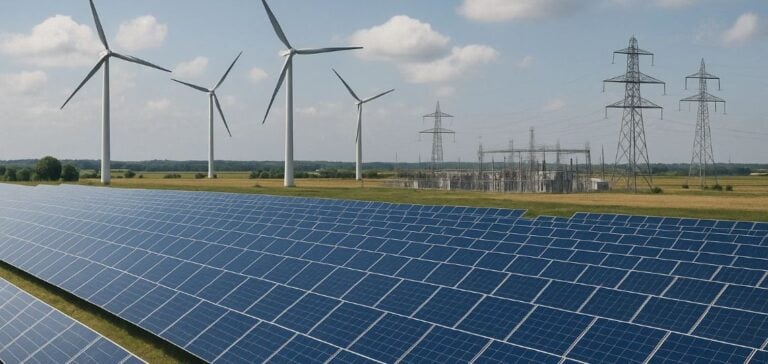Renewable electricity production in France reached 150 TWh in 2024, representing a 10.6% increase compared to 2023. This growth is mainly attributed to higher hydropower output, supported by favourable hydrological conditions, and a significant rise in installed solar capacities.
Installed capacities see strong growth
By the end of 2024, the total renewable electricity capacity, including hydropower, solar photovoltaic, onshore wind, offshore wind, and bioenergy, stood at 76.7 GW. This marks an annual increase of more than 6.7 GW. Solar contributed the most with an additional 4,961 MW, followed by onshore wind (+1,091 MW) and offshore wind (+665 MW).
Renewable production covered 33.9% of electricity consumption in metropolitan France. In comparison, it accounted for 27.8% of total national electricity production from all sources.
Solar increases, onshore wind declines
Installed solar capacity reached 24,333 MW as of 31 December 2024, an increase of 3,137 MW over the previous year. It generated 24.8 TWh, or 5.7% of national consumption, up 10.3% year-on-year. This contribution varies by season, peaking in the summer.
Onshore wind, despite growing to 22,875 MW in installed capacity, saw production fall to 42.8 TWh in 2024, down 12.6% from 2023. The technology covered 9.6% of electricity consumption in metropolitan France.
Offshore wind reaches new milestone
Offshore wind produced 4 TWh in 2024, a 111.2% increase compared to the previous year. This rise is linked to the ramp-up of the Saint-Brieuc, Fécamp, and Saint-Nazaire wind farms, which now total 1,508 MW in capacity. Offshore wind accounted for 0.9% of national consumption, with further growth underway.
Hydropower dominates renewable output
The hydropower fleet, with a stable capacity of 25,716 MW, generated 69.8 TWh in 2024, a 27.3% increase. It remains the leading renewable electricity source in France, covering 15.8% of metropolitan consumption. The performance reflects particularly favourable hydrological conditions during the year.
Bioenergy: limited but steady contribution
The bioenergy electricity sector, including energy recovery from waste, had a capacity of 2,272 MW. It generated 8.5 TWh in 2024, a slight increase of 1.5% compared to the previous year. It accounted for 1.9% of national electricity consumption.
These results are taken from the Panorama de l’électricité renouvelable as of 31 December 2024, published by the Syndicat des énergies renouvelables (SER), Réseau de Transport d’Électricité (RTE), Enedis, and Agence ORE (Opérateurs de Réseaux d’Énergie).






















